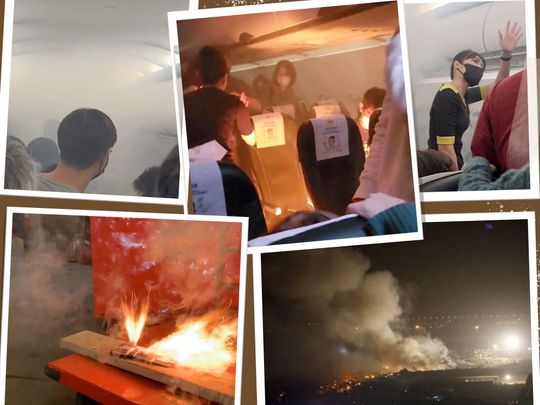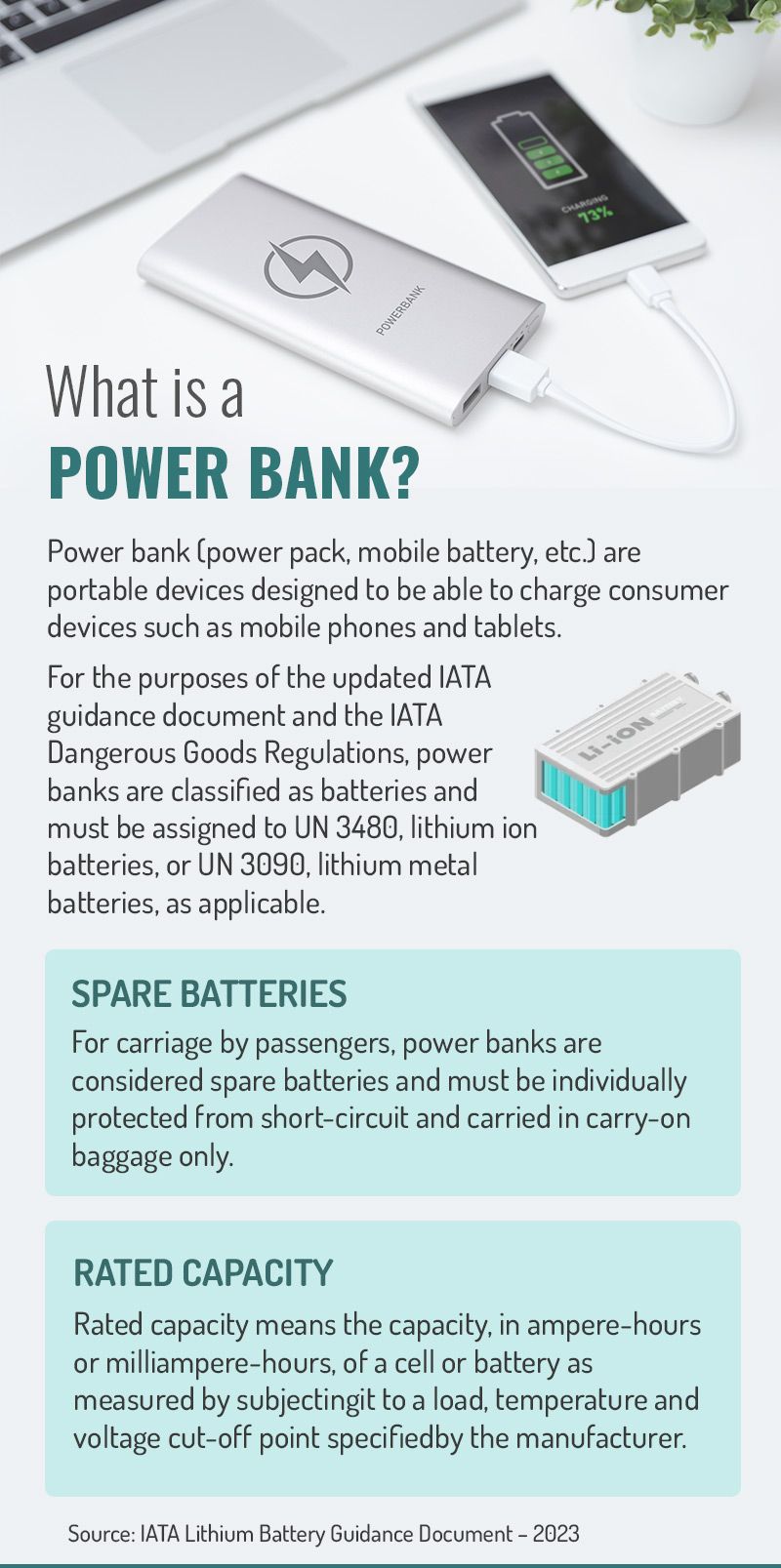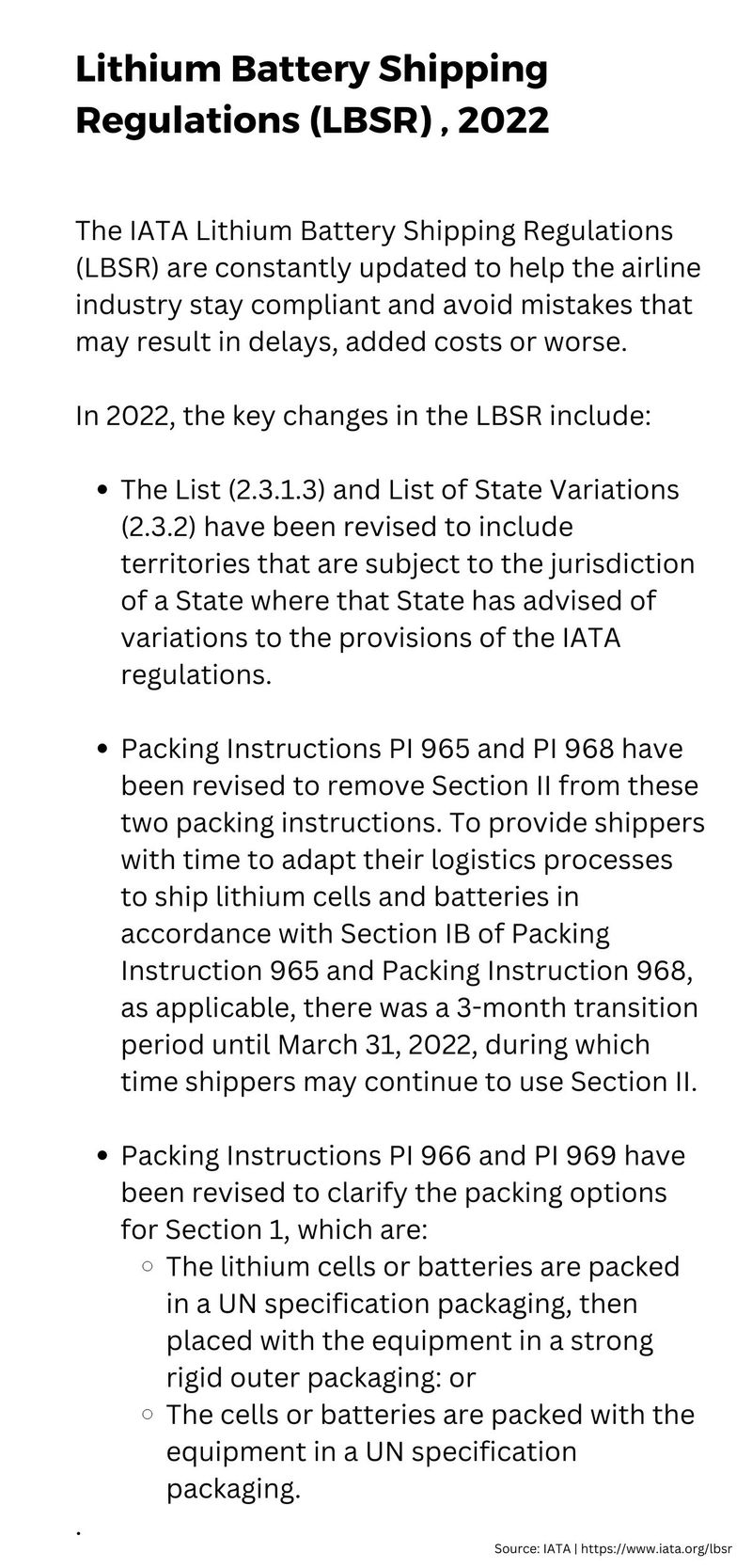
Lithium batteries are widely used for a variety of applications — including powering portable gadgets, laptop computers, and even electric vehicles.
However, the growing use of these batteries has raised questions regarding their safety during air travel. The current state of lithium batteries is such that they can catch fire — if they are damaged or overheated.
In general, lithium batteries are considered dangerous goods — and, as such, require special packaging for transportation.
The International Air Travel Association (IATA) has recently issued updates on the rules and regulations governing the air transport of lithium batteries. Some basics every flyer should know:
When did IATA update the guidelines on lithium batteries?
There's a 2023 update. It was also updated in 2022. For several years, IATA has been upgrading its rules and regulations for the air transport of lithium batteries. The initial set of regulations went into effect in 2006. Since then, IATA has continued to update and enhance them in response to new safety concerns and events.
As new incidents occur and new technologies are created, the regulations for the air transport of lithium batteries continue to evolve.

What are the reported incidents of lithium battery fire inside a jet?
There have been several reported incidents of lithium battery fires on aircraft in recent years.
Some of the notable incidents:
• On January 11, 2023, passengers on a flight from Taipei to Singapore were left shocked when a power bank suddenly caught fire onboard. The footage taken by passengers of the Scoot flight TR993 went viral on social media.
• In 2016, a fire broke out on a Japan Airlines plane that was carrying lithium-ion batteries in cargo. The incident resulted in significant damage to the aircraft.
• In 2014, a fire broke out on an Asiana Airlines passenger plane that was carrying lithium-ion batteries in cargo. The incident resulted in significant damage to the aircraft and forced an emergency landing.
• In 2013, a cargo plane carrying lithium-ion batteries caught fire shortly after takeoff in Dubai, causing the aircraft to crash.
These incidents highlight the importance of ensuring that lithium batteries are properly packaged and marked to prevent fires from occurring on aircraft.
What are the classifications for lithium batteries under new IATA rules?
The IATA has classified lithium batteries into two categories: Section IA and Section IB, based on the state of charge and the watt-hour rating of the battery.

Section IA
Section IA batteries have a state of charge of less than 30% and a watt-hour rating of less than 100 Wh, while Section IB batteries have a state of charge of more than 30% and a watt-hour rating of more than 100 Wh.
The IATA has also introduced specific requirements for the packaging of lithium batteries depending on their category.
Section IA batteries can be carried in bulk on passenger aircraft as long as they are packaged properly to prevent short circuits. The packaging must be made of material that will not allow the batteries to move around during transit and that will prevent the terminals from coming into contact with metal or other conductive materials.
The packaging must also be marked with the appropriate UN number and lithium battery handling label. In addition, passengers are limited to a maximum of two Section IA batteries per person, with each battery not exceeding 160 Wh.
• It is used for goods that are not classified as "dangerous" in the strict sense but which, during transportation, may pose a threat to safety, health, or the environment due to their properties.
• This includes goods such as lithium-ion batteries, magnetic materials, and some dry ice.
• UN 3480: "Power banks" are portable devices designed to be able to charge consumer devices such as mobile phones and tablets.
• For carriage by passengers, power banks are considered “spare batteries” and must be individually protected from short-circuit and carried in carry-on baggage only.
• Based on IATA Dangerous Goods Regulations, power banks are to be classified as batteries, and must be assigned either to UN 3480, lithium-ion batteries, or UN 3090, lithium metal batteries, as applicable.
• UN 3090 (Class 9) are lithium metal batteries – defined as batteries NOT packed with or installed with the equipment.
• Since 2015, Lithium Metal Batteries UN 3090, when shipped by themselves (not contained in or packed with equipment), are forbidden for transport as cargo on passenger aircraft. These batteries are allowed for transport as cargo only on flights “only cargo”.
• The packaging and transportation requirements for Class 9 goods are regulated under IATA, International Civil Aviation Organisation (ICAO) and the International Maritime Dangerous Goods (IMDG) Code.
Section IB
Section IB batteries, on the other hand, are not permitted to be carried in bulk on passenger aircraft, with the exception of spare batteries used for mobility aids. These batteries must be packaged in such a way as to prevent short circuits and must be placed in a protective pouch or a similar container.
The packaging must also be marked with the appropriate UN number and lithium battery handling label, and passengers are limited to a maximum of two Section IB batteries per person.
The IATA rules are in place to ensure the safety of passengers, crew, and the aircraft itself.
Can I bring a powerbank inside the aircraft under new IATA safety rules?
Yes, you may bring a power bank inside an airline cabin under the current IATA safety rules. But there are certain things to know and restrictions to consider when bringing powerbanks inside a commercial jet:
- The size of the powerbank (in terms of Watt-hour rating);
- The amount of charge it can carry (the percentage of charge);
- The number of power banks an individual passenger can carry.
- The markings for the powerbanks.

According to IATA, power banks are classified as Section IA batteries — which means they have a state of charge of less than 30% and a watt-hour rating of less than 100 Wh.
The increase in undeclared lithium battery shipments, and the rise in inexpensive knock-off batteries, have raised concerns about their safety implications, prompting more stringent rules on markings and declaration of origin.
A recent report of a power bank catching fire inside a passenger jet is just one of a growing number of incidents, and highlights the need to raise awareness about the widely-used power device.
Passengers are allowed to carry power banks in their carry-on baggage — or on their person — but they are limited to a maximum of two per person. Each power bank must not exceed 160 Wh.
More importantly, passengers must also ensure that their power banks are packaged properly to prevent short circuits — and are marked with the appropriate UN number and lithium battery handling label.
It is always advisable to check with your airline for any additional restrictions or requirements before travelling with a power bank.
IATA counts 290 member-companies and 83% of total air traffic.
The DGR is a global reference for shipping dangerous goods by air, and the only standard recognised by the global airline industry.
What are the IATA instructions on powerbank markings — on how to package and label lithium batteries for air transportation?
IATA provides the following instructions on how to package and label lithium batteries for air transportation:
Packaging:
- Lithium batteries must be packaged in strong, fire-resistant packaging, such as a fibreboard box.
- The package must be capable of preventing short circuits, including insulation of the terminals by tape or other means.
- The package must be marked with the appropriate UN number and lithium battery handling label, indicating the type and quantity of lithium batteries contained within.
Labelling:
- Lithium batteries must be clearly marked with the UN number UN3480, UN3090, or UN38.3, depending on the type of battery.
- The lithium battery handling label must be placed on the package in a prominent location, and must not be obscured by other labels or packaging materials.
- The lithium battery handling label must contain the words "Lithium Ion Batteries" or "Lithium Metal Batteries," as appropriate, and the corresponding UN number.
- If the package contains lithium batteries that are packaged with or contained in equipment, the equipment must be labeled with the words "Contains Lithium Ion Batteries" or "Contains Lithium Metal Batteries," as appropriate, and the corresponding UN number.
As the rules governing the transport of lithium batteries by air continue to evolve and may be subject to further changes, it is best to check with the IATA or your airline for the most up-to-date information and requirements.
It is always best to confirm the most recent information and criteria with the IATA or your airline. The IATA website has the most up-to-date information on its lithium battery standards, including instructions on how to package and label lithium batteries for air transportation.
Ultimately, it is the responsibility of passengers and airlines to ensure that these regulations are followed to avoid delays and prevent incidents.







